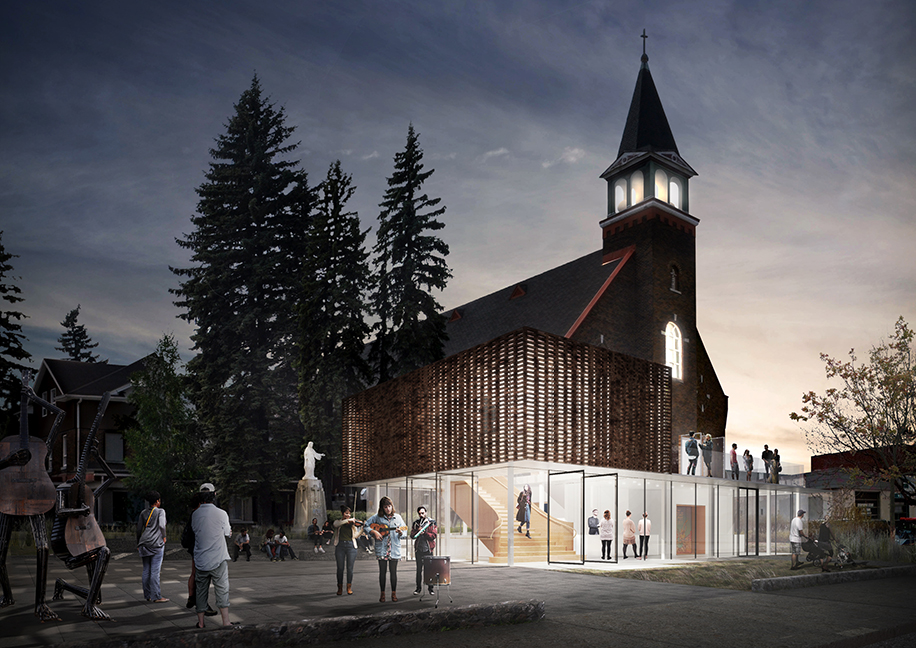Since the dawn of civilization, public buildings have shaped towns and cities, and have provided identity of place for hundreds, sometimes thousands, of years. It is, for example, worthy to note that of the seven ancient wonders of the world, five were buildings. The others (the Colossus at Rhodes and the statue of Zeus at Olympia) would fall into the category of public sculpture.

The Greek temple, the Italian Duomo, the Gothic cathedral, museums, art galleries and opera houses are iconic symbols of cities and enlightened civil/political/religious thinking. In North America, some may even argue that sports venues (Maddison Square Gardens or the Montreal Forum) and transmission towers (CN Tower or the Seattle Space Needle) have provided emblematic recognition of the urban centres in which they are situated.
With the possible exception of The Rooms in St. John’s and perhaps the Fogo Island Inn (although the latter is not a public building per se) urban centres and towns in Newfoundland and Labrador generally do not feature such architectural symbols. And that’s okay to an extent because locals and visitors have come to identify with natural landscapes and heritage precincts of bright coloured clapboard. The architecture of public buildings is not a priority. This truly is a shame, and I hope this post may help explain why.
A short time ago, Stephan Chevalier and Sergio Morales gave a lecture on their work at the Plantation in Quidi Vidi Village. Chevalier +Morales Architectes are a small Montreal architectural practice that have experienced remarkable success in recent years. They directly attribute this success to an innovative provincial policy that requires new buildings that receive funding from or fall under the auspices of the Department of Culture and Communications (MCC) or the Municipal Affairs and the Occupation of the Territory (MAMOT) to be subject to an architectural design competition.
An architectural design competition is essentially a contest to obtain a range of architectural concept designs allowing the selection of what is deemed to be the best entry for detailed design and ultimately construction. Sometimes such competitions are open to all architects and sometimes they are “two stage” whereby a shortlist is developed to determine final entrants based on an initial written submission. The Ordre des Architectes du Québec (OAQ) have, in conjunction with the provincial government, prepared strict rules for architectural competitions. The Royal Architectural Institute of Canada have done the same nationally. Competitions must conform to these rules in order to be “sanctioned” by governing provincial architectural associations.
So, going back to the thrust of the Chevalier Morales presentation, we find that they routinely enter such competitions. Sometimes they win. Sometimes they lose. Yet every entry serves to advance their success and form a philosophical basis to approach the next competition. This is good for architects in that they are chosen to design a building based on their ingenuity and approach to a given project – not on the basis of a rote resume that indicates they have designed, say, three such buildings in the last five years. It also allows talented young architects a shot at rewarding/paying work based on their skillsets in design. Young firms that would otherwise never stand a chance to land such commissions.

So what is the benefit to the public? Well I bet you can imagine, especially if you are living here in NL.
Instead of a pre-engineered, crinkly tin, municipal box into which an architectural program has been crammed with little functional success and even less aesthetic merit, you actually get thoughtful, inspired buildings that have a corresponding effect on the people that use them: thought and inspiration. The ancients had this sorted out.
The point is that accountants and politicians here will continue to push public buildings down to the lowest common denominator. And provincial civil servants responsible for architectural procurement have de-evolved into immutable, knuckle-dragging, P3/design-build Neanderthals.
Every neighbourhood in Quebec is clambering for a new library / cultural centre. Art, literature and education have become as important as hockey – and there is no denying the importance or impact of hockey in Quebec. These all continue to define and redefine that province’s identity.
We here in the Far East however, see our young and talented leave the province in droves. The most prevalent quote: “There’s nothing here for me.” But communities such as Fogo and Bonavista are bucking this trend despite its overwhelming prevalence. And they did it based on education and entrepreneurship. Just the kind of tools you may get from inspired public buildings – new, repurposed and/or restored.

But we won’t be getting any of these soon as our politicians cannot connect the dots and our bureaucrats can’t even find the puzzle book they’re in.
Instead, our young architects are leaving because there is no work. The Annual General Meeting of the Architects Association this year was the most poorly attended and depressing event that I have experienced in forty years.
And yes I know: the public doesn’t give a rat’s ass.
Do you think perhaps that it may have something to do with the fact that the public is so utterly uninspired by the built environment that surrounds them?
How is our context any different than Quebec’s when it comes to the design of public buildings? Well culturally it isn’t. Politically, past NL governments awarded design work to friends and cronies. Now, through their procurement process they either award to the cheapest (i.e. least innovative) proposal or send the work away to large mainland firms (the ones with the rote resumes). They have diminished the role of architecture. They seek to further the lowest common denominator.
Our future cultural heritage is at present being defined by engineers, lawyers and accountants. You’ll really want to be around for that.

Well said